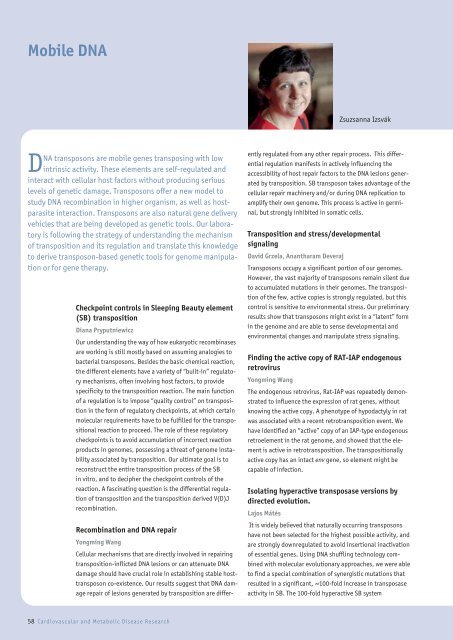of the Max - MDC
of the Max - MDC
of the Max - MDC
You also want an ePaper? Increase the reach of your titles
YUMPU automatically turns print PDFs into web optimized ePapers that Google loves.
Mobile DNA<br />
Zsuzsanna Izsvák<br />
DNA transposons are mobile genes transposing with low<br />
intrinsic activity. These elements are self-regulated and<br />
interact with cellular host factors without producing serious<br />
levels <strong>of</strong> genetic damage. Transposons <strong>of</strong>fer a new model to<br />
study DNA recombination in higher organism, as well as hostparasite<br />
interaction. Transposons are also natural gene delivery<br />
vehicles that are being developed as genetic tools. Our laboratory<br />
is following <strong>the</strong> strategy <strong>of</strong> understanding <strong>the</strong> mechanism<br />
<strong>of</strong> transposition and its regulation and translate this knowledge<br />
to derive transposon-based genetic tools for genome manipulation<br />
or for gene <strong>the</strong>rapy.<br />
Checkpoint controls in Sleeping Beauty element<br />
(SB) transposition<br />
Diana Pryputniewicz<br />
Our understanding <strong>the</strong> way <strong>of</strong> how eukaryotic recombinases<br />
are working is still mostly based on assuming analogies to<br />
bacterial transposons. Besides <strong>the</strong> basic chemical reaction,<br />
<strong>the</strong> different elements have a variety <strong>of</strong> “built-in” regulatory<br />
mechanisms, <strong>of</strong>ten involving host factors, to provide<br />
specificity to <strong>the</strong> transposition reaction. The main function<br />
<strong>of</strong> a regulation is to impose “quality control” on transposition<br />
in <strong>the</strong> form <strong>of</strong> regulatory checkpoints, at which certain<br />
molecular requirements have to be fulfilled for <strong>the</strong> transpositional<br />
reaction to proceed. The role <strong>of</strong> <strong>the</strong>se regulatory<br />
checkpoints is to avoid accumulation <strong>of</strong> incorrect reaction<br />
products in genomes, possessing a threat <strong>of</strong> genome instability<br />
associated by transposition. Our ultimate goal is to<br />
reconstruct <strong>the</strong> entire transposition process <strong>of</strong> <strong>the</strong> SB<br />
in vitro, and to decipher <strong>the</strong> checkpoint controls <strong>of</strong> <strong>the</strong><br />
reaction. A fascinating question is <strong>the</strong> differential regulation<br />
<strong>of</strong> transposition and <strong>the</strong> transposition derived V(D)J<br />
recombination.<br />
Recombination and DNA repair<br />
Yongming Wang<br />
Cellular mechanisms that are directly involved in repairing<br />
transposition-inflicted DNA lesions or can attenuate DNA<br />
damage should have crucial role in establishing stable hosttransposon<br />
co-existence. Our results suggest that DNA damage<br />
repair <strong>of</strong> lesions generated by transposition are differently<br />
regulated from any o<strong>the</strong>r repair process. This differential<br />
regulation manifests in actively influencing <strong>the</strong><br />
accessibility <strong>of</strong> host repair factors to <strong>the</strong> DNA lesions generated<br />
by transposition. SB transposon takes advantage <strong>of</strong> <strong>the</strong><br />
cellular repair machinery and/or during DNA replication to<br />
amplify <strong>the</strong>ir own genome. This process is active in germinal,<br />
but strongly inhibited in somatic cells.<br />
Transposition and stress/developmental<br />
signaling<br />
David Grzela, Anantharam Deveraj<br />
Transposons occupy a significant portion <strong>of</strong> our genomes.<br />
However, <strong>the</strong> vast majority <strong>of</strong> transposons remain silent due<br />
to accumulated mutations in <strong>the</strong>ir genomes. The transposition<br />
<strong>of</strong> <strong>the</strong> few, active copies is strongly regulated, but this<br />
control is sensitive to environmental stress. Our preliminary<br />
results show that transposons might exist in a “latent” form<br />
in <strong>the</strong> genome and are able to sense developmental and<br />
environmental changes and manipulate stress signaling.<br />
Finding <strong>the</strong> active copy <strong>of</strong> RAT-IAP endogenous<br />
retrovirus<br />
Yongming Wang<br />
The endogenous retrovirus, Rat-IAP was repeatedly demonstrated<br />
to influence <strong>the</strong> expression <strong>of</strong> rat genes, without<br />
knowing <strong>the</strong> active copy. A phenotype <strong>of</strong> hypodactyly in rat<br />
was associated with a recent retrotransposition event. We<br />
have identified an “active” copy <strong>of</strong> an IAP-type endogenous<br />
retroelement in <strong>the</strong> rat genome, and showed that <strong>the</strong> element<br />
is active in retrotransposition. The transpositionally<br />
active copy has an intact env gene, so element might be<br />
capable <strong>of</strong> infection.<br />
Isolating hyperactive transposase versions by<br />
directed evolution.<br />
Lajos Mátés<br />
It is widely believed that naturally occurring transposons<br />
have not been selected for <strong>the</strong> highest possible activity, and<br />
are strongly downregulated to avoid insertional inactivation<br />
<strong>of</strong> essential genes. Using DNA shuffling technology combined<br />
with molecular evolutionary approaches, we were able<br />
to find a special combination <strong>of</strong> synergistic mutations that<br />
resulted in a significant, ∼100-fold increase in transposase<br />
activity in SB. The 100-fold hyperactive SB system<br />
58 Cardiovascular and Metabolic Disease Research
















